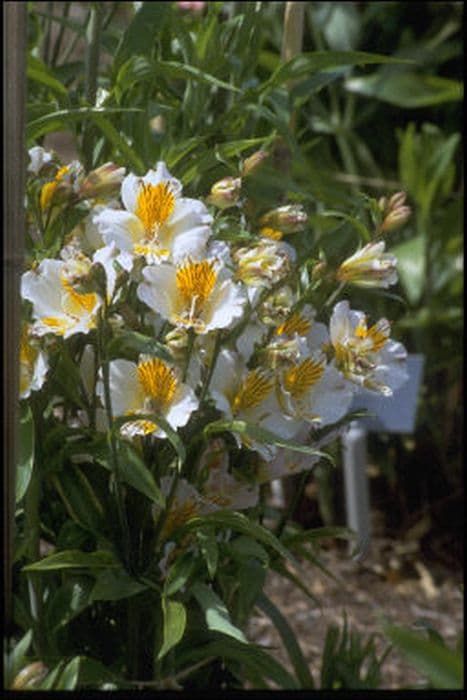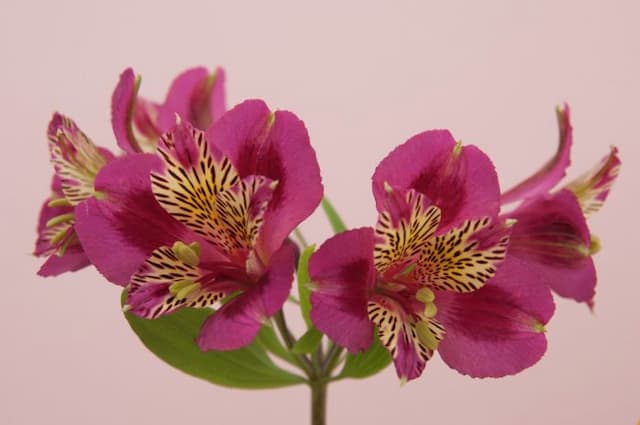Peruvian Lily Alstroemeria 'Oriana'

ABOUT
Alstroemeria 'Oriana' is a perennial plant known for its striking and colorful flowers. The blossoms of this variety are particularly eye-catching, with a vibrant blend of golden yellow petals that are often adorned with flecks and streaks of deep pink or red, adding a dramatic flair to the overall visual impact. Each flower showcases a symmetrical arrangement of six slightly curved petals that create a trumpet-like form, making them stand out in garden displays or as cut flowers in arrangements. The interior of the petals is typically marked with conspicuous lines that guide pollinators to the center of the flower where the reproductive parts are held. The flowers bloom in clusters at the top of long, slender, green stalks, which are surrounded by lance-shaped leaves. The foliage of Alstroemeria 'Oriana' is a bright green and provides a lush backdrop that highlights the impressive show of blooms. This perennial is appreciated not only for its aesthetic appeal but also for its resilience and the ability to bloom for an extended period, often starting in late spring and continuing into early fall, providing a long-lasting display of color in a garden setting. Alstroemeria 'Oriana' plants are capable of adapting to a variety of conditions, which, coupled with their spectacular florals, makes them a favorite among gardeners and flower enthusiasts.
About this plant
 Names
NamesFamily
Alstroemeriaceae.
Synonyms
Peruvian Lily, Lily of the Incas, Alstroemeria.
Common names
Alstroemeria 'Oriana'
 Toxicity
ToxicityTo humans
The Peruvian Lily (Alstroemeria) is considered mildly toxic to humans. If ingested, it can cause symptoms like nausea, vomiting, and diarrhea. Also, handling the plant may cause skin irritation or dermatitis for those with sensitive skin. Ingesting large quantities of the plant, especially the roots, could lead to more serious consequences such as abdominal pain or other gastrointestinal issues. It's advisable to keep this plant out of reach of children who might accidentally ingest it.
To pets
The Peruvian Lily is considered non-toxic to dogs and cats. However, ingestion might occasionally result in mild gastrointestinal upset such as vomiting or diarrhea due to the foreign nature of the plant material, but serious toxicity or long-term effects are not typically expected. Nevertheless, it is still best to prevent pets from ingesting plants, as individual reactions can vary.
 Characteristics
CharacteristicsLife cycle
Perennials
Foliage type
Deciduous
Color of leaves
Green
Flower color
Mixed
Height
2-3 feet (60-90 cm)
Spread
1-2 feet (30-60 cm)
Plant type
Herb
Hardiness zones
7
Native area
South America
Benefits
 General Benefits
General Benefits- Long Blooming Period: The Peruvian Lily 'Oriana' typically has a long flowering season, providing vibrant color over many months.
- Attractive to Pollinators: Bees, butterflies, and hummingbirds are drawn to the flowers, which can help pollinate other plants in the garden.
- Cut Flower Use: The blooms are long-lasting when cut, making them ideal for bouquets and floral arrangements.
- Drought Tolerance: Though they prefer regular watering, Peruvian Lilies can tolerate periods of drought once established.
- Versatile Planting: Suitable for planting in beds, borders, and containers, providing flexibility in garden design.
- Ease of Care: Requires minimal pruning and is relatively easy to care for once established, making it suitable for gardeners of all levels.
- Vibrant Colors: The variety 'Oriana' offers stunning and vivid colors that can enhance the visual appeal of any garden space.
- Perennial Growth: As a perennial, it returns year after year, providing a long-term addition to the garden.
 Medical Properties
Medical PropertiesThis plant is not used for medical purposes.
 Air-purifying Qualities
Air-purifying QualitiesThis plant is not specifically known for air purifying qualities.
 Other Uses
Other Uses- Photography subjects: Alstroemeria flowers, due to their unique beauty and intricate patterns, are commonly used by photographers seeking to capture the diversity and intricacy of flower species.
- Artistic inspiration: The Peruvian lily's striking appearance can inspire artists for various projects including paintings, textile designs, and even tattoos.
- Educational tools: These flowers can be used in botany classes to teach students about plant structure, hybridization, and the diversity of plant species.
- Theme gardens: Alstroemeria 'Oriana' can be used to create a South American themed garden due to its origins, adding cultural context to garden designs.
- Botanical illustration: The complex and colorful patterns of the Peruvian lily make it a popular choice for botanical illustrators honing their skills.
- Wedding decorations: They can add exotic flair to wedding décor, not just in flower arrangements but also in the overall theme and design elements of a wedding venue.
- Color palettes: Designers can use the vibrant colors of Alstroemeria 'Oriana' to develop color schemes for interior designs or fashion collections.
- Fragrance inspiration: Though not particularly known for a strong scent, the subtle fragrance of Alstroemeria can be used as inspiration for creating candles or perfumes.
- Floral crafts: The sturdy stems and long-lasting flowers make them suitable for creating dried flower arrangements or other decorative crafts.
- Greeting cards and wrapping paper: The patterns of Alstroemeria are often replicated on greeting cards and wrapping papers for an elegant, nature-inspired look.
Interesting Facts
 Feng Shui
Feng ShuiThe Peruvian Lily is not used in Feng Shui practice.
 Zodiac Sign Compitability
Zodiac Sign CompitabilityThe Peruvian Lily is not used in astrology practice.
 Plant Symbolism
Plant Symbolism- Friendship: Alstroemeria, commonly referred to as the Peruvian Lily or Lily of the Incas, often symbolizes a strong bond between friends due to its long-lasting blooms, reflecting the longevity and endurance of friendship.
- Devotion and Support: The twisted leaves of the Peruvian Lily signify the intertwining of lives, suggesting mutual support and devotion between people.
- Wealth and Prosperity: With its multiple flowers on a single stem, the Peruvian Lily can represent a bounty of opportunities, leading to wealth and prosperity.
- Personal Growth: The diverse and vibrant colors found on the petals symbolize growth and the idea of constantly striving to better oneself.
- Resilience and Survival: The ability of the Peruvian Lily to adapt to various soil types and environments reflects the qualities of resilience and survival.
- Achieving Aspirations: This plant is also seen as a symbol of striving for and achieving one's aspirations, embodied by the reaching form of the flowering stalk.
 Water
WaterPeruvian lily prefers consistent moisture, so water the plant thoroughly whenever the top inch of soil feels dry to the touch. Usually, this means watering once every week, but this may vary based on climate and soil conditions. Apply approximately half a gallon of water at each watering, ensuring you water deeply to promote strong root development. Adjust the frequency to accommodate for rainfall and avoid waterlogging the soil. During the peak of summer in hot climates, you might need to water twice a week to maintain adequate moisture levels.
 Light
LightPeruvian lily thrives in bright, indirect light or partial shade. The ideal spot for this plant would be one that receives filtered sunlight for most of the day or direct morning light followed by afternoon shade. Avoid placing Peruvian lily in full, harsh sunlight, which can scorch the leaves and compromise the health of the plant.
 Temperature
TemperaturePeruvian lily does best in temperatures ranging from 65 to 80 degrees Fahrenheit. The plant can survive temperatures as low as 40 degrees Fahrenheit but should be protected from frost. In hot climates, it's crucial to ensure that the Peruvian lily doesn't get too warm; prolonged exposure to temperatures above 90 degrees Fahrenheit may stress the plant.
 Pruning
PruningPeruvian lily benefits from pruning to remove spent flowers and encourage further blooming. Deadhead regularly by gently pulling the spent flower stem from the base to promote new growth. The best time to prune for shape and size is in the late fall or early winter when the plant enters dormancy. This helps maintain an aesthetically pleasing shape and healthy, vigorous growth in the following season.
 Cleaning
CleaningAs needed
 Soil
SoilThe Peruvian Lily (Alstroemeria 'Oriana') thrives in a well-draining soil mix rich in organic matter, such as a blend of loam, peat, and coarse sand. It prefers a soil pH slightly acidic to neutral, ranging from 6.0 to 7.0. A balanced soil environment ensures healthy growth and flowering.
 Repotting
RepottingPeruvian Lilies should generally be repotted every two to three years to refresh the soil and accommodate root growth. These plants can become quite large underground, so ensure the new pot is significantly larger than the root ball.
 Humidity & Misting
Humidity & MistingPeruvian Lilies enjoy moderate to high humidity levels, ideally around 40-60%. Maintaining this humidity range will support their lush foliage and vibrant blooms.
 Suitable locations
Suitable locationsIndoor
Place in bright, indirect light and maintain moderate humidity.
Outdoor
Full sun to partial shade, shelter from strong winds, mulched.
Hardiness zone
7-11 USDA
 Life cycle
Life cycleThe life of the Alstroemeria 'Oriana', commonly known as Peruvian Lily or Lily of the Incas, begins with seed germination, which requires a warm environment and can take several weeks. Once the seedlings develop true leaves, the young plants can be transplanted into individual pots. The Peruvian Lily then enters a vegetative stage where it focuses on root and foliage growth; during this period, the plant requires exposure to full sun to partial shade, regular watering, and well-draining soil. As it matures, the Peruvian Lily starts to form its distinctive trumpet-shaped flowers, often in vibrant colors, which can occur multiple times throughout the growing season if optimal conditions are maintained. After the flowering phase, the plant goes dormant, particularly in cooler climates where it may die back to the ground to survive winter. Finally, if conditions are right, the Peruvian Lily will re-emerge from its rhizomes the following spring to begin the cycle anew.
 Propogation
PropogationPropogation time
Spring-Early Summer
Alstroemeria 'Oriana', commonly known as Peruvian Lily or Lily of the Incas, is often propagated through division, which is the most popular method for this perennial plant. Division is typically done in the spring or early summer when the plant has emerged from dormancy and you can easily see the clumps. To propagate by division, carefully dig up the Alstroemeria clump and gently separate the rhizomes with your hands or a sharp knife. Each section should have at least one growth point or 'eye'. Replant these divisions at the same depth they were growing previously, spacing them about 12 to 24 inches (approximately 30 to 60 centimeters) apart to give them room to grow. Ensure the soil is well-draining and the planting site gets adequate sunlight. Water the new divisions well and continue to provide regular moisture as they establish themselves.





![Peruvian lily [H.R.H. Princess Alice]](/_next/image?url=https%3A%2F%2Fplants-admin.emdemapps.com%2Fimages%2Fplants%2F%2Fimages%2F604b55e81c8b0.png&w=640&q=75)

![Peruvian lily [Inca Coral]](/_next/image?url=https%3A%2F%2Fplants-admin.emdemapps.com%2Fimages%2Fplants%2F%2Fimages%2F604b5b79b85ce.png&w=640&q=75)
![Peruvian lily [Inca Exotica]](/_next/image?url=https%3A%2F%2Fplants-admin.emdemapps.com%2Fimages%2Fplants%2F%2Fimages%2F604b5ec0e34a9.png&w=640&q=75)
![Peruvian lily [Inca Milk]](/_next/image?url=https%3A%2F%2Fplants-admin.emdemapps.com%2Fimages%2Fplants%2F%2Fimages%2F604b5f14b0b6a.png&w=640&q=75)